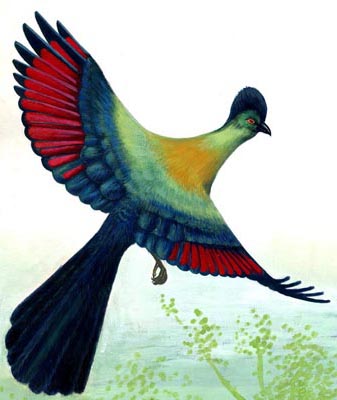The ENTC now has a new website, at www.entc.org.sz
Our logo is adapted from a painting by Phillip Dlamini, 1998, of a purple crested turaco. In traditional Swazi dress, the red feathers feature in the royal headdress, so this bird illustration is not only a symbol for wildlife conservation, but also of cultural heritage.


Contributed by Ngwane Dlamini, Mlawula Nature Reserve, 2008
The Lubombo Conservancy is an integral part of the greater Lubombo Transfrontier Conservation Area (LTFCA), which was formulated through a collective trilateral agreement between the governments of Swaziland, Mozambique and South Africa. The core objective of the LTFCA is to form a larger eco-region conservation area incorporating all protected areas within the member states to ensure that ecosystems are all well managed, natural resources are utilised in a sustainable manner and to promote trans-boundary ecotourism development. The LTFCA incorporates different nature reserves, game reserves, forest parks and other conservation sanctuaries that are to be managed on a united front and form a neat continuous corridor of well managed natural resources.
In April 1999, with the support of the Peace Parks Foundation, Eswatini's contributed to the LTFCA by forming the Lubombo Conservancy. After much consideration the Lubombo region, in the north-eastern part of Eswatini was identified as an ideal area to set up a single conservancy area that will cater to all the requirements of the LTFCA.
The Lubombo Conservancy comprises of five established reserves that include Mlawula Nature Reserve, Shewula Nature Reserve, Mbuluzi Game reserve, Hlane National Park and Inyoni Yami Eswatini Irrigation Scheme (IYSIS). The five conservation areas are hosts to the most extensive and historical conservation area within the Kingdom of Eswatini, with approximately 60 000 hectares of continuous block of land that can be utilised to enhance conservation efforts in the country.
The conservation areas fits perfectly into the core vision of the whole Lubombo Conservancy, which is to 'facilitate the long term conservation of north-eastern Eswatini's ecosystems through co-operative nature conservation management, coupled with the development of conservation based opportunities that would benefit and contribute to the improvement of the quality of life of all people in the region.'
The future aim of the Lubombo Conservancy is to establish one reserve where animals can freely roam between the reserves, without any hindrances from fences that separate the different conservation areas. This reserve will open up opportunities for visitors to enjoy easy access to harmonising big game, superb bird and mammal viewing amidst breathtaking scenery that the region offers.
The Conservancy is unique in that it combines national, private and community-owned reserves that have come together in a co-ordinated effort to ensure that there is proper and sustainable conservation of ecosystems, which also enhances the quality of life of people in this region. It cradles intrinsic values to the Swazi nation as it plays host to the annual 'butimba' (traditional hunting event), led by His Royal Excellence His Majesty King Mswati III. The Conservancy serves as an ideal place to engage in quality self-exploration, discovery and fulfillment ensuring that all visitors leave with a remarkable experience they will treasure for years to come. It offers numerous accommodation options for visitors ranging from thatched rest camps, campsites and tented bush camps, to private and community lodges. It is perfectly situated on the eastern route between the Kruger National Park and KwaZulu Natal, also providing an ideal stop en route to Mozambique.
Progress on the Conservancy is currently at an advanced state, which has seen the formulation of a managing committee that has been entrusted with co-ordinating all aspects attached to the conservancy. Numerous co-ordination reliant projects have been identified and implemented by the respective member conservancies, which have been put in place to capitalise fully on all the opportunities that the conservancy has to offer.
Mlawula Nature Reserve is dedicated to ensure that it plays its part in ensuring that the Conservancy is a resounding success that the whole region can be proud of. Facilities and resources at the reserve are more than thoroughly equipped to cater to all the needs that visitors who have the blessed opportunity to visit this truly unique reserve, housed in a Conservancy with a difference.
Lubombo Conservancy Hiking Trails (map from the Sugar Museum, pdf version here)

Our Contacts:
Head Quarters: (+268) 2416 1489/1179
Email: info@sntc.org.sz
King Sobhuza II Park: (+268) 2416 1489/1179
Email: ksmp@sntc.org.sz
National Museum: (+268) 2416 1489/1179
Email: curator@sntc.org.sz
Copyright © ESWATINI NATIONAL TRUST COMMISSION
Malolotja Nature Reserve: (+268) 2444 3241 / (+268) 2416 1480
Email: culturalvillage@sntc.org.sz
Mantenga Nature Reserve and Swati Cultural Village: 2416 1151/1178
Email: culturalvillage@sntc.org.sz
Mlawula Nature Reserve: (+268) 2383 8885 (Reception)
(+268) 2383 8453 (Senior Warden)
Email: culturalvillage@sntc.org.sz
Magadzavane Lodge: (+268) 2343 5108/9
Email: magadzavane@sntc.org.sz